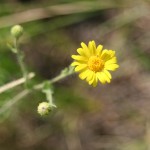Camphorweed , Camphor Weed
Heterotheca subaxillaris (Lam.) Britt. & Rusby
Asteraceae (Sunflower Family)
Description
Because its name is used for different plants across the United States, Camphorweed must be checked by scientific name for proper identification. Also known as H. latifolia by some authors, it is generally recognized by the strong camphor-like scent when the leaves are crushed. Camphorweed is a mostly annual, warm-season native that generally emerges from the ground as a single stem, then branches several inches above the ground. It is often described as having a one-sided, unbalanced appearance. It can reach up to 3 ft or 90 cm tall. Its stems and leaves are covered in spreading white hairs that may be sticky to the touch. Leaves are elliptic to lanceolate, alternate, and have toothed margins. It has showy, bright yellow flowers with hairy leaves clasping the spindly branches. Blooming occurs from July through November, depending on moisture. It propagates by seed and readily self-sows. The forage value of Camphorweed is fair for most grazing animals, but it is unpalatable for grazing livestock on open ranges. It is attractive to pollinators.Habitat
Camphorweed can grow profusely in disturbed sites and a variety of soil types, preferring well-drained, sandy soils. Its distribution ranges from New Jersey to Florida, West to Texas, and North to Kansas. Native habitats include prairies, coastal dunes, grasslands, pinelands, and roadsides.Images
Plant Characteristics
Flower Color: Yellow
Seed Type: Non-Encapsulated
Duration: Annual, Biennial
Stem Texture: Hairy
Growth Habit: Forbs/Broadleaf
Leaf Shape
 : Simple with Pinnate or Parallel Venation
: Simple with Pinnate or Parallel Venation
Season: Warm
Distribution
 : 01 - Pineywoods, 02 - Gulf Prairies and Marshes, 03 - Post Oak Savannah, 04 - Blackland Prairies, 05 - Cross Timbers and Prairies, 06 - South Texas Plains, 07 - Edwards Plateau, 08 - Rolling Plains, 09 - High Plains, 10 - Trans-Pecos
: 01 - Pineywoods, 02 - Gulf Prairies and Marshes, 03 - Post Oak Savannah, 04 - Blackland Prairies, 05 - Cross Timbers and Prairies, 06 - South Texas Plains, 07 - Edwards Plateau, 08 - Rolling Plains, 09 - High Plains, 10 - Trans-Pecos
Distributions
Distribution refers to the ecological region in Texas that a plant has been found. You can also view a clickable map.
Book: Brush and Weeds of Texas Rangelands (B-6208)
Collection: Brush and Weeds, Wild Flowers





